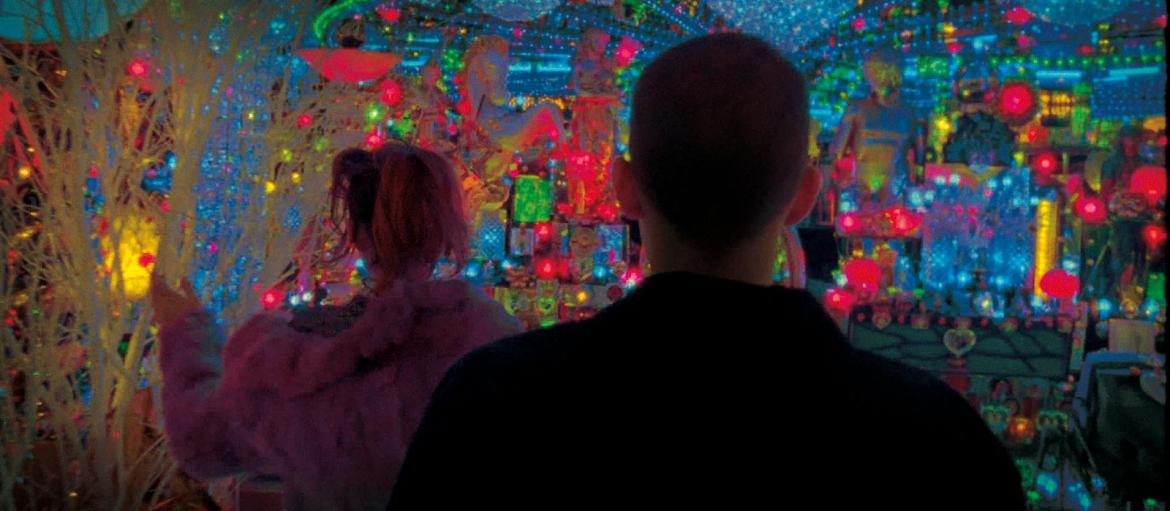
Enter the Void (Movie Review)
If you were gonna pick a filmmaker to show you the crazed and compulsive rhythms reverberating inside the mind of an expatriate hallucinogen addict living in Tokyo you might well peg David Cronenberg or Tom Tykwer to handle the tour. Gaspar Noé probably wouldn’t be your first choice. If you throw in that this tour has a quasi-spiritual bent built on ideas from the Bardo Thodol (Tibetan Book of the Dead) the Noé equation seems even more unlikely. Fortunately for fans of Noé’s work his newest feature “Enter the Void” continues the helmer’s application of chaotic technical flourishes and heavy emotional content married to graphic imagery in order to craft a universe unique to his oeuvre.
Oscar is a lost soul, twenty-something piecing together an existence in the sensory annihilation candy store that is Tokyo’s Shinjuku district. He sells drugs to get by, takes drugs as frequently as he can afford and spends a lot of time with a tryptonaut named Alex who keeps pushing the “Tibetan Book of the Dead” on him. Oscar’s sister Linda lives with him and the two are uncommonly intimate, but Oscar shares very few details of his alienated, high risk lifestyle with her. One evening Oscar goes to meet his friend and sales partner Victor at a tripper’s pub known as “The Void”. Things go sour fast and Oscar is cornered in a bathroom stall by police. As he frantically works to dump pills down the drain, he shouts at the cops that he has a gun and is shot and killed.
The narrative then takes the viewer on a Bardo Thodol styled flashback as Oscar’s disembodied soul travels through his life (primarily in an over the shoulder shot) revisiting all the formative experiences leading up to his demise. We see childhood trauma, the reasons for his close bond with his sister, the degeneration of his spirit on the alienating streets of Tokyo and the moment of his death repeated.
A second trip through time and space follows from high over head as Oscar watches the reactions and fates of those who played a significant role in his life in Japan. Eventually his purgatorial navigations land him in a Japanese Love Hotel populated by his friends and acquaintances. He watches them copulate and eventually finds his way into the sex act between his sister and Alex. It’s worth noting that the end maybe partly Noé having a laugh as Oscar and Linda’s incestuous undertones are realized with an unexpected kind of congress.
Like me, you may well emerge from Oscar’s trip asking, ‘What does it all mean?’ I’m not sure that Noé wants you to know his intentions. He claims that this film is not a statement of belief in the posthumous labyrinth structure detailed in the Bardo Thodol. In his interviews Noé simply relates that Oscar’s experience is at the moment of death, not after, and that it is driven by suggestions derived from the character’s recent reading and discussion of the Tibetan text. The idea that 2.5 hours of film have been spent to show us the subconscious journey at a drug-addled wastrel’s moment of death actually seems perfectly in line with the provocateur side of Noé’s game. It also rings decidedly evasive and hackneyed, much like the flimsy final statement of “Irreversible”, LE TEMPS DETRUIT TOUT or “Time Destroys Everything”. “Irreversible” was a profoundly realized revenge parable that exposed the motivations and flaws that drove the main character to what was ultimately an annihilating and empty act. Perhaps his trite explanation of the plot of “Enter the Void” is Noé’s way of keeping his foot firmly planted in what Tom Gunning coined as “The Cinema of Attractions”. The Cinema of Attractions is a style of filmmaking that endeavors to engage the audience on a level that keeps them focused mainly on the imagery; even going so far as to break the narrative and draw attention to seemingly incongruous visuals in order to do so.
I am a fan of Gaspar Noé; there may not be a bolder hand working within the near mainstream of the film world. The mechanics of his shock machine suits my attraction to more extreme ideas and imagery, but it is his ability to allow actors room to breath and create genuine emotional gravity that really blows me away. Sadly, this is the where I felt let down by “Enter the Void”. It is true that Oscar has had his verve sucked away by trauma and drug use, but even the passages of the film that are meant to convey and elicit great emotion seem too distant to be successful. Some of this may be down to the use of intentionally detached camera perspectives. But being as this film is about the destructive power of unresolved trauma and the physical and chemical artifice that people use to escape pain I found myself wanting more from the story points where the actors reconnect the frayed ends of their emotion circuitry.
“Enter the Void” is a technical masterwork. Invisible cuts and ambitious tracking shots, bold perspective changes and deftly integrated CG make the eye-candy appeal run right off the charts (which, as noted above would seem to be a major aim for Noé). That appeal combined with a desire to glean the thematic intent of the director make it a work worth visiting. If you are expecting to be throttled, then punched in the gut like “Irreversible” or slimed and shower-readied like “I Stand Alone”, you will leave disappointed. There is a lot of graphic sex, some violence and a bedpan with a dead fetus in it, but as visually stunning as it is, the film also works to gradually move the viewer away from strictly visceral attachments to the grimy portions of world it envisages. This was a choice that I think would have worked well for me if the portions where we are supposed to feel the pain and deep connections resonated a little more strongly. To be fair to Noé, this is probably a film that is impossible to digest in one sitting. Perhaps a second pass will make me feel more invested in the whole package.

